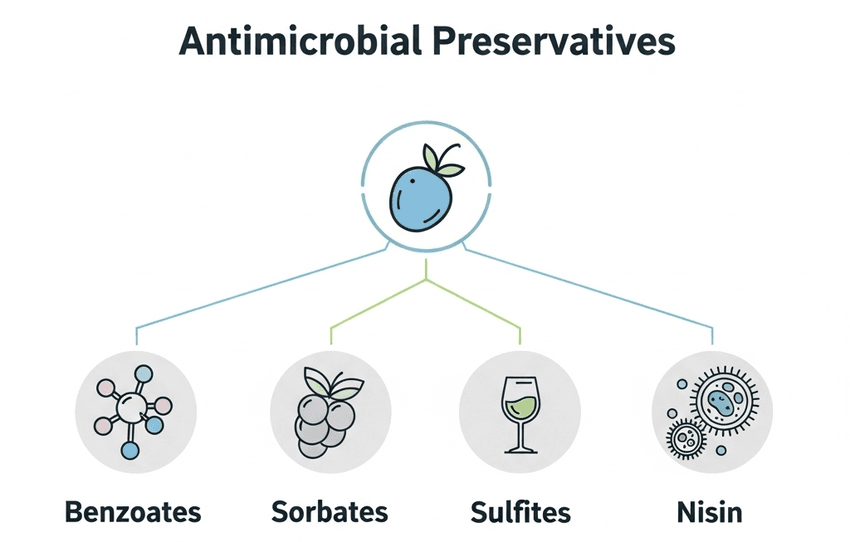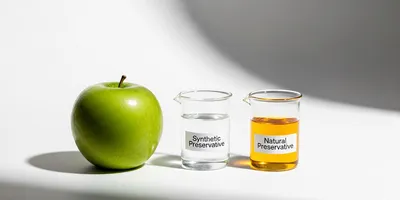In the intricate world of food science, the concept of a product's shelf-life is a direct function of its stability against microbial spoilage, enzymatic degradation, and chemical reactions. While thermal and non-thermal processing methods provide a foundational layer of preservation, the strategic use of food preservatives is often essential to provide lasting protection and maintain product quality. For laboratory professionals, understanding the multifaceted role of preservatives—from synthetic compounds to naturally derived substances—is critical for formulating safe, stable, and commercially viable food products.
Food preservatives are substances added to food to prevent or retard spoilage caused by microorganisms (such as bacteria, yeasts, and molds) and to inhibit undesirable chemical changes, like oxidation and rancidity. The challenge lies in selecting effective agents that do not adversely affect the product's sensory attributes or consumer perception. The modern food industry navigates a complex landscape where traditional chemical preservatives coexist with a growing demand for "clean label" and naturally derived alternatives, pushing innovation in both areas of research and development.
The Two Major Classes of Food Preservatives
Food preservatives are broadly categorized based on their primary function: antimicrobial agents that combat microbial growth and antioxidants that prevent oxidative deterioration. Often, a combination of both types is necessary to achieve comprehensive preservation. The efficacy of a preservative is highly dependent on the food matrix, including its pH, water activity, and the presence of other compounds that might interact with the preservative.
1. Antimicrobial Preservatives
These are substances that inhibit the growth of or kill microorganisms. Their mechanisms of action vary but often involve disrupting microbial cell membranes, inhibiting enzyme activity, or interfering with DNA synthesis.

Antimicrobial preservatives can kill or inhibit the growth of microorganisms.
GEMINI (2025)
- Benzoic Acid and Benzoates: Widely used in acidic foods such as fruit juices, jams, and soft drinks. Benzoic acid works by entering microbial cells in its undissociated form and interfering with intracellular pH and metabolism.
- Sorbic Acid and Sorbates: Effective against yeasts and molds, particularly in products like cheese, wine, and baked goods. Sorbic acid's mechanism is thought to involve inhibition of key enzymes in microbial respiration.
- Sulfites: Used as both an antimicrobial and an antioxidant, particularly in dried fruits and wine. They are effective against molds and some bacteria but can cause allergic reactions in sensitive individuals, requiring careful labeling.
- Nisin: A naturally occurring antimicrobial peptide produced by certain bacteria. It is effective against gram-positive bacteria, including spores, and is used in cheese, processed meats, and canned foods.
2. Antioxidant Preservatives
These agents prevent or slow down the oxidation of fats, oils, and other food components, thus preserving flavor, color, and nutritional value. Oxidation is a major cause of rancidity in fatty foods and browning in fruits and vegetables.
- Synthetic Antioxidants:
- Butylated Hydroxyanisole (BHA) and Butylated Hydroxytoluene (BHT): Common synthetic antioxidants used in fats, oils, and processed foods. They work by donating a hydrogen atom to free radicals, breaking the chain reaction of oxidation.
- Tertiary-Butylhydroquinone (TBHQ): A highly effective antioxidant for vegetable oils and fried snack foods, with strong resistance to heat.
- Natural Antioxidants:
- Ascorbic Acid (Vitamin C): A powerful antioxidant that can prevent browning in fruits and vegetables. It is also used in beverages and baked goods.
- Tocopherols (Vitamin E): A naturally occurring antioxidant used to protect oils and fat-rich foods from rancidity.
The Rise of Natural Preservation Methods
Driven by consumer preferences for "clean label" products with fewer synthetic additives, the food industry has increasingly turned to natural preservation methods. These methods leverage compounds derived from plants, animals, or microorganisms that exhibit preservative properties.
- Plant Extracts:
- Rosemary Extract: Contains carnosic acid and carnosol, potent antioxidants that are highly effective in protecting meat and poultry products from oxidative rancidity.
- Oregano and Green Tea Extracts: Rich in phenolic compounds with both antioxidant and antimicrobial properties.
- Fermentation-Derived Preservatives:
- Vinegar and Lactic Acid: Produced through fermentation, these acids lower the pH of a food product, creating an environment that is unfavorable for many microorganisms.
- Cultured Dextrose: A fermented corn sugar that contains a variety of compounds, including organic acids, that inhibit mold and yeast growth in baked goods.
- Essential Oils and Spices:
- Many essential oils, such as those from cloves, cinnamon, and thyme, contain compounds with potent antimicrobial properties. These can be used in small quantities to inhibit the growth of pathogens and spoilage microbes.
- Spices like rosemary, oregano, and cloves have long been used in traditional cuisine for their preservative qualities, which are now being studied for industrial applications.
Synergistic Approaches and Regulatory Compliance
Effective preservation often involves a synergistic approach, combining multiple methods to achieve a desired level of protection. For instance, a product might be subjected to a mild thermal treatment, followed by the addition of a chemical antioxidant, and then packaged under a modified atmosphere. This hurdle technology approach uses a combination of preservation factors to create a hostile environment for microorganisms.
For laboratory professionals, regulatory compliance is a non-negotiable aspect of using food preservatives. Regulatory bodies such as the Food and Drug Administration (FDA) in the United States and the European Food Safety Authority (EFSA) maintain strict lists of approved preservatives and their maximum usage levels. This ensures that preservatives are used safely and do not pose a health risk to consumers. The responsibility lies with the food scientist to not only select an effective preservative but also to ensure its use is within legal limits and is appropriately declared on the product label.
A Balanced Approach to Food Preservation
The science of food preservation is a dynamic field, constantly evolving to meet the dual demands of safety and quality. Both synthetic and natural food preservatives offer valuable tools for extending shelf-life and ensuring product integrity. While chemical preservatives remain indispensable for many applications, the rise of natural alternatives provides an exciting new frontier for innovation. For the modern food professional, success lies in a balanced approach: leveraging the proven efficacy of traditional methods while exploring and validating the potential of new, naturally derived solutions. This balanced strategy ensures that food products are not only safe and stable but also align with consumer expectations for wholesome, minimally processed foods.
Frequently Asked Questions about Food Preservatives
What is the difference between an antimicrobial and an antioxidant preservative?
Lab Management Certificate
The Lab Management certificate is more than training—it’s a professional advantage.
Gain critical skills and IACET-approved CEUs that make a measurable difference.
An antimicrobial preservative inhibits the growth of microorganisms like bacteria, yeasts, and molds. An antioxidant preservative prevents or slows down chemical reactions, such as oxidation, that lead to rancidity and color changes in food.
Why are some preservatives considered "natural"?
Natural preservatives are derived from natural sources, such as plants, animals, or microorganisms. This contrasts with synthetic or chemical preservatives that are manufactured in a lab. The term "natural" is largely driven by marketing and consumer perception, as both types of preservatives are subject to the same strict safety regulations.
Are all food preservatives safe?
All approved food preservatives have undergone extensive safety testing and are used within legally defined maximum limits. Regulatory agencies review the safety of these additives to ensure they do not pose a health risk to consumers at the levels at which they are consumed.
How does pH affect the function of a preservative?
The pH of a food product is a critical factor in the efficacy of many preservatives, particularly organic acids like benzoic and sorbic acid. These acids are most effective at low pH values, where they exist in their undissociated, more lipid-soluble form, allowing them to more easily penetrate and disrupt microbial cells.













